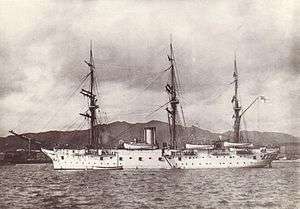SMS Gneisenau (1879)
 Geneisenau at anchor | |
| History | |
|---|---|
| Name: | SMS Gneisenau |
| Namesake: | Field Marshal August von Gneisenau |
| Builder: | Kaiserliche Werft Danzig, Danzig |
| Laid down: | June 1877 |
| Launched: | 4 September 1879 |
| Completed: | 3 October 1880 |
| Fate: | Sunk in storm off Málaga, Spain, 16 December 1900 |
| General characteristics | |
| Class and type: | Bismarck-class corvette |
| Displacement: | 3,089 t (3,040 long tons) |
| Length: | 82 m (269 ft 0 in) |
| Beam: | 13.7 m (44 ft 11 in) |
| Draught: | 6.3 m (20 ft 8 in) |
| Installed power: | |
| Propulsion: |
|
| Speed: | 12 knots (22 km/h; 14 mph) |
| Range: | 1,940 nmi (3,590 km; 2,230 mi) at 10 knots (19 km/h; 12 mph) |
| Complement: | 452 (including trainees) |
| Armament: |
|
SMS Gneisenau was a Bismarck-class corvette built for the German Imperial Navy (Kaiserliche Marine) in the late 1870s. The ship was named after the Prussian Field Marshal August von Gneisenau.
Gneisenau served in the training of officer candidates, for which the ship undertook numerous voyages abroad. An incident of desertion by a crew member is alleged to have occurred in 1885 at Sydney. On 16 December 1900 the ship sank in a storm near the harbor of Málaga, Spain, after grounding at the harbor mole because a failure of the propulsion machinery. Forty crew members perished, including the captain and first officer. According to The Naval Annual, she "had on board 14 naval officers, including Captain Kretchmann in command, 49 cadets and 6 other officers, and about 380 men. The unfortunate ship was lying outside the harbour at Malaga, when a great storm arose, causing her to drag her anchors, and she was driven with much force against the Eastern Mole and completely wrecked."[1]
Citations
- ↑ Leyland, John (ed.). The Naval Annual, 1901. p. 48.
References
- Gardiner, Robert; Chesneau, Roger; Kolesnik, Eugene M., eds. (1979). Conway's All the World's Fighting Ships: 1860–1905. London: Conway Maritime Press. ISBN 0-85177-133-5.
- Gröner, Erich (1990). German Warships: 1815–1945. Annapolis: Naval Institute Press. ISBN 0-87021-790-9. OCLC 22101769.